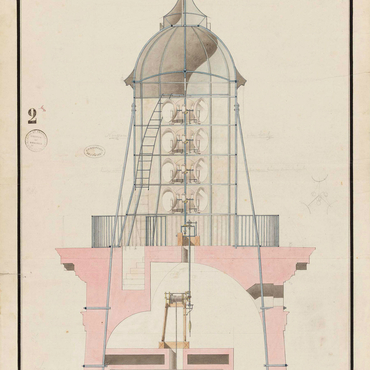
- Home
- The Age of Enlightement
- A scientific project
- Borda and Lenoir’s device for Cordouan
Étienne Lenoir (1744–1832) was one of the greatest makers of scientific instruments of the late eighteenth century. He had already created the repeating circle (a predecessor of the sextant) for the Chevalier de Borda, and the two devices used on La Pérouse's expedition. He was constantly sought out by the Royal Academy of Sciences, to which he supplied the measuring instruments used to calculate the Paris Meridian in 1792 and the first standard metre in 1799. Lenoir was thus commissioned to create the new rotating device for Cordouan in 1786. Initially, he designed a test device consisting of ten silvered reflectors and a clock for the rotation. This prototype was presented to the king on 28 July 1788 in the gardens of Versailles; it was admired by the entire court. Another, larger apparatus, consisting of twelve copper parabolic reflectors measuring 90 cm in diameter, was made at the Romily-sur-Seine manufactory. It was built and installed at Cordouan starting on 15 August, with the help of the clockmaker Mulotin from Dieppe. The spectacular device represented the pinnacle of lighting techniques the time: Argand lamps, a clock device, glass flues, metal reflectors – all of it rotating – and ventilation. This ambitious device was put into service on 29 August 1790. Nevertheless, disillusion set in shortly thereafter – the weight of the reflectors threatened the fragile clockworks, and their arrangement created periods of darkness. The lamps were placed too close to the glass plates. The poor-quality reflectors from Versailles had to be re-installed. Worse yet, the lamp was only visible from 6 or 7 leagues away (23 to 27 km), far less than originally planned. The device that represented the apex of eighteenth-century catoptrics turned out to be a near-total failure. All of the effort and energy put into it had resulted in no decisive advance. The lighthouse would have to wait another thirty years for that.







